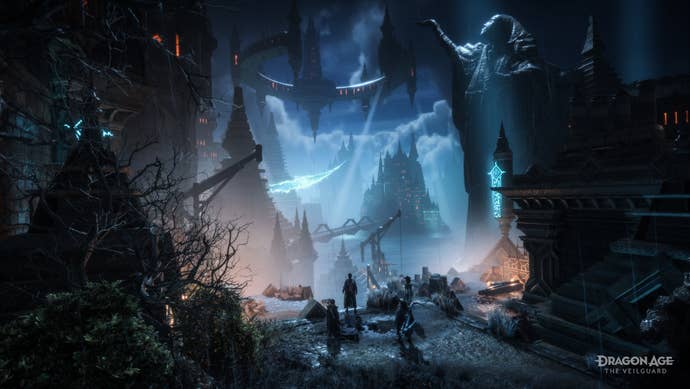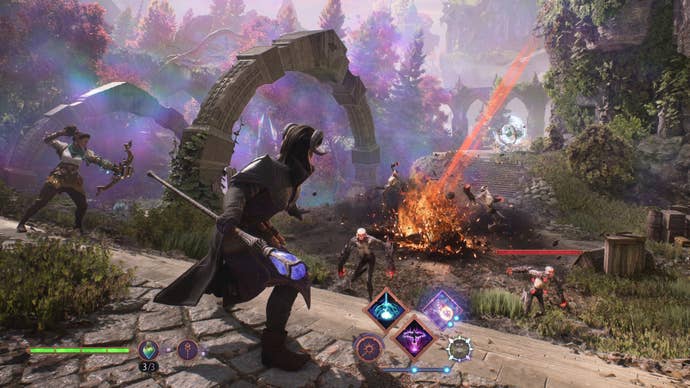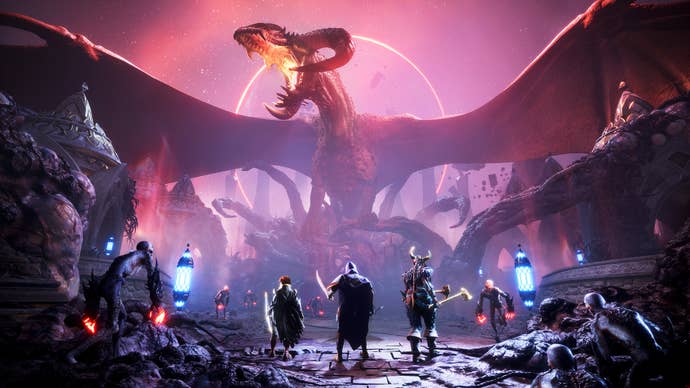Dragon Age: The Veilguard is so much more than you think it is, and it channels BioWare’s best
Leaning on companions? Borrowing from the structure of Mass Effect 2 and 3? References to Final Fantasy 10 and 12 for RPG systems? Pinch me.
Having now played seven hours of Dragon Age: The Veilguard, I think it’s fair to say that thus far, the game’s marketing messaging hasn’t quite landed.
When I saw the game back at Summer Games Fest 2024, I came away with the impression of a role-playing series nipped, tucked, and truncated to meet the demands of an action game-driven market. But after playing the game at length, that feeling has dissipated: The Veilguard is far more than EA’s marketing has so far managed to illuminate.
Back in June, I compared Dragon Age’s latest outing to Final Fantasy 16, another franchise sequel that is really rather good but that also visibly struggles to grapple with its franchise legacy and the shadow cast by the likes of God of War 2018. But actually, The Veilguard appears to have navigated those choppy waters with a far defter hand - and the result left me absolutely chomping at the bit to experience the final, full thing.
Let me put it this way. Dragon Age Origins was conceived as a spiritual successor to Baldur’s Gate. Dragon Age 2 structurally borrowed much from the first Mass Effect. Dragon Age Inquisition offered an open-world take for a post-Skyrim, pre-Witcher 3 world.
The Veilguard’s greatest inspiration, at least in structure, appears to be both Mass Effect 2 and 3. These are BioWare’s finest games, so that’s no bad thing - but then layered atop this is a far deeper, and far more D&D-faithful RPG progression offering.

Let’s talk about overall game structure first. This is very much still in that BioWare wheelhouse. This time around, your version of the Normandy or Skyhold is called The Lighthouse. Here, you’ll hang out with your companions, advance your relationships, craft, take stock, and generally exercise your leadership chops as ‘Rook’, the de facto boss of the Veilguard. So far, so familiar.
When you leave the Lighthouse, you’ll be going to one of two types of zones. The first type are linear stages that advance the story (most of these are action-driven, but I played at least one that was more focused on grim atmospheric vibes) while the second type are functionally secondary hubs (think Mass Effect’s Citadel or Omega) that are home to general hangouts with a variety of friendly faces, shops, side quests, and combat, all at once.
The developer is keen to not make any actual numbered size comparisons to Inquisition, but broadly speaking it’s realistic to say that while Inquisition featured a handful of truly huge zones, The Veilguard instead pivots to carefully curated smaller areas - but a lot of them.
In my day with the game, I saw quite a number of areas, all seemingly from the game’s first act or thereabouts. I should also note that I did see some zones deftly reused - a city first visited as a thriving town at peace as a casual hub, then revisited in the guise of a linear action stage after one of my choices put it under siege. And then, afterwards, as a shattered town trying to rebuild. There's a clever economy of assets here, though deployed in a way that doesn’t feel cheap.

You can sense that the developers didn’t want the more linear action stages to simply be a rush of enemies - and so much is accomplished through visual storytelling that enlivens the experience of each. One quest sees the characters in a sort-of magical air bubble underwater, exploring flooded ruins (curiously a setting I also saw in Expedition 33 at Gamescom). Outside the barrier, fish and aquatic flora shimmer in the haze. In places, the magical barrier holding back the sea is at breaking point, water perilously dripping from cracks across its surface.
As well as fighting, zones like this are punctuated with little puzzles. You know the type; crystals to destroy to unlock doors, or another type of crystal you’ll need to escort to power up some magical device to open up the next location you need to progress to. Maybe some malevolent blight needs to be destroyed to open up a path, or a hole blasted in a wall with a ballista. It’s simple stuff, but it keeps you busy, and breaks up the combat. This is the flow of many action-adventure games - but what sets a BioWare offering apart is how this all dovetails with getting to know a cast of characters and making the story truly your own.
All of this feels, like I’ve said, quite a lot like the second and third Mass Effect games. But there’s one area where Dragon Age’s fourth entry sets itself apart: in the nuts and bolts of crunchy, satisfying role-playing systems. Put simply, there’s a hell of a lot here. Moment-to-moment this might have a touch of full-blown action game about it; at times it can even look a little bit Devil May Cry. The action feels legitimate and satisfying moment-to-moment, too. With that said, under the hood beats the brave heart of a full-on, full-fat role-playing game.

I probably should’ve seen this coming. When I spoke to The Veilguard’s director earlier in the summer, she compared what they’d built to Final Fantasy 10 & 12’s beloved Sphere and License Grid setups. When we spoke again during this preview event, we ended up nerding out about Xenosaga. She’s the real deal. But seeing her RPG proclivities expressed in-game is a whole other matter to simply hearing about it. It’s there, it’s real - and it provides a whole new layer of possibility to each combat encounter or each and every ‘linear’ action stage.
The Mage’s skill grid, for instance, has over a hundred skills spread across six subsections - and that’s without counting three mutually exclusive Class Specialisation trees at the extremes of the different build directions you can go in. It’s up to you what path you beat through the tree’s interconnected web of abilities, which specialisation you go for, and what sort of combat experience you want to have.
A Mage could focus on skills that give you battlefield control, arresting the movement options of enemies to entrap them. Or you could become a Spellblade, mixing melee and magic by pairing your magical staff with an enchanted dagger for up-close assaults. The options are myriad. There’s a similar breadth across each of the three classes (Warrior, Mage, and Rogue) - so that’s three sprawling, unique player character skill trees to toy with across multiple playthroughs.
This isn’t exactly earth-shattering innovation - it’s stuff we’ve seen before. With that said, it’s a sort of mechanical depth that has rarely been paired with RPGs that structure the rest of the game in a more approachable, bite-sized, action-adventure manner. Usually the baby of mechanical role-playing depth gets tossed out with the bathwater - but not so here.

Crucially, this is the sort of RPG system that has enough depth that you should be able to crack the game open like an egg. You don’t have to do that, of course - but for the min/maxers among you this certainly appears to be the sort of game you’ll be able to carefully build game-breaking setups in, between the skill trees and the gear that’s on offer. It’s the sort of game where a single new piece of armour you find might have some bonus that’ll send you to craft an entirely new build designed to maximise its bonus. The Veilguard is built for this, too - making respeccing and refunding skill points easy and unlimited, encouraging wild experimentation.
So, there is meat on the bone. Don’t let trailers that focus on quippy, sexy characters that you’ll want to romance and helm-splitting combat fool you. That style is there, yes. But so, too, is substance.
When I call that stuff style, too, I want to be clear: it’s not all surface. The characters, the world, the narrative - they are all substantive, too. There’s bravery in taking the series in new places on show, for one. There’s some gentle shaving off of some of the sharper edges - sometimes in the form of lovely quality-of-life changes like the in-game map making it absolutely clear when a companion has something new to say, but other times in slightly more controversial streamlining, like conversation options now basically always boiling down to Nice, Sarcastic, or Tough options.
There’s things that can’t be judged in a day’s hands-on, of course. The developer says it's proud to have structured the game around companions this time - they call them “load-bearing pillars” of the entire experience. The logic, it’s explained, is that BioWare is really good at doing companions - so why not structure the whole game specifically around them? It makes sense. It can’t be judged on just a slice of the game - but for what it’s worth, after a day with them I did begin to feel like this might be the best Dragon Age ensemble yet. The story had me intrigued, too.
The star of the show remains how the game plays, though. Combat feels good - the Rogue is ridiculous. The RPG systems have surprising depth. The entire game is just giving more than I expected.
In fact, the game’s biggest sin so far is simply that Jump and the Interact button are one and the same - a pet hate of mine. But I can forgive that. Especially if the rest of the experience lives up to this first extended hands-on. Roll on October.
Dragon Age: The Veilguard launches October 31 for PS5, Xbox Series, and PC. It costs $69.99/£69.99 on PS5 and Xbox Series X/S, and $59.99/£49.99 on PC, and there are various special editions available.




.jpg?width=291&height=164&fit=crop&quality=80&format=jpg&auto=webp)




